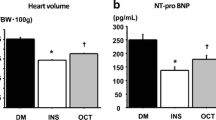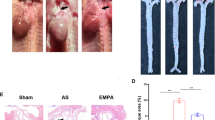Abstract
Several clinical studies have provided evidence that blockade of the renin–angiotensin system (RAS) prevents onset of type 2 diabetes. In mice models of type 2 diabetes, some angiotensin II type 1 receptor blockers (ARBs) reportedly protect against reduction of beta-cell mass. Although several ARBs are commercially available, the effect of these drugs on beta-cell mass has not been compared directly. The purpose of this study was to compare the protective effects on beta cell mass of olmesartan, an ARB with strong binding capacity to the angiotensin II type 1 receptor, and telmisartan, an ARB with partial peroxisome proliferator-activated receptor-γ (PPARγ) activity. Eight-week-old female db/db mice were treated with olmesartan medoxomil (3.0 mg/kg body weight/day), telmisartan (1.5 mg/kg body weight/day), or placebo for 6 weeks. This was followed by examination of glucose tolerance, insulin sensitivity, and islet morphology in each group. Random glucose level after treatment with the two ARBs was slightly, but significantly, lower than in the placebo group whereas glucose tolerance and insulin sensitivity were similar among the three groups. Beta-cell mass was higher and staining intensities for NAD(P)H oxidase components and markers of oxidative stress were lower in islets of the olmesartan and telmisartan-treated groups than in those of the placebo group. Our results reveal that olmesartan and telmisartan had comparable effects on reduction of beta-cell mass in db/db mice via their antioxidant effects.



Similar content being viewed by others

Abbreviations
- AT1(2)R:
-
Angiotensin II type 1 (2) receptor
- ARBs:
-
Angiotensin II (Ang II) receptor blockers
- IPGTT:
-
Intraperitoneal glucose tolerance test
- ITT:
-
Insulin tolerance test
- RAS:
-
Renin–angiotensin system
References
Butler AE, Janson J, Bonner-Weir S, Ritzel R, Rizza RA, Butler PC. Beta-cell deficit and increased β-cell apoptosis in humans with type 2 diabetes. Diabetes. 2003;52(1):102–10.
Rhodes CJ. Type 2 diabetes-a matter of beta-cell life and death? Science. 2005;307(5708):380–4.
DeFronzo RA. Dysfunctional fat cells, lipotoxicity and type 2 diabetes. Int J Clin Pract Suppl. 2004;143:9–21.
Unger RH, Zhou YT. Lipotoxicity of beta-cells in obesity and in other causes of fatty acid spillover. Diabetes. 2001;50(Suppl 1):S118–21.
Leung PS, Carlsson PO. Tissue renin–angiotensin system: its expression, localization, regulation and potential role in the pancreas. J Mol Endocrinol. 2001;26(3):155–64.
Lau T, Carlsson PO, Leung PS. Evidence for a local angiotensin-generating system and dose-dependent inhibition of glucose-stimulated insulin release by angiotensin II in isolated pancreatic islets. Diabetologia. 2004;47(2):240–8.
Carlsson PO, Berne C, Jansson L. Angiotensin II and the endocrine pancreas: effects on islet blood flow and insulin secretion in rats. Diabetologia. 1998;41(2):127–33.
Inoguchi T, Li P, Umeda F, Yu HY, Kakimoto M, Imamura M, Aoki T, Etoh T, Hashimoto T, Naruse M, Sano H, Utsumi H, Nawata H. High glucose level and free fatty acid stimulate reactive oxygen species production through protein kinase C–dependent activation of NAD(P)H oxidase in cultured vascular cells. Diabetes. 2000;49(11):1939–45.
Oliveira HR, Verlengia R, Carvalho CR, Britto LR, Curi R, Carpinelli AR. Pancreatic beta-cells express phagocyte-like NAD(P)H oxidase. Diabetes. 2003;52(6):1457–63.
McMurray JJ, Holman RR, Haffner SM, Bethel MA, Holzhauer B, Hua TA, Belenkov Y, Boolell M, Buse JB, Buckley BM, Chacra AR, Chiang FT, Charbonnel B, Chow CC, Davies MJ, Deedwania P, Diem P, Einhorn D, Fonseca V, Fulcher GR, Gaciong Z, Gaztambide S, Giles T, Horton E, Ilkova H, Jenssen T, Kahn SE, Krum H, Laakso M, Leiter LA, Levitt NS, Mareev V, Martinez F, Masson C, Mazzone T, Meaney E, Nesto R, Pan C, Prager R, Raptis SA, Rutten GE, Sandstroem H, Schaper F, Scheen A, Schmitz O, Sinay I, Soska V, Stender S, Tamas G, Tognoni G, Tuomilehto J, Villamil AS, Vozar J, Califf RM. Effect of valsartan on the incidence of diabetes and cardiovascular events. N Engl J Med. 362(16):1477–1490.
Abuissa H, Jones PG, Marso SP, O’Keefe JH Jr. Angiotensin-converting enzyme inhibitors or angiotensin receptor blockers for prevention of type 2 diabetes: a meta-analysis of randomized clinical trials. J Am Coll Cardiol. 2005;46(5):821–6.
Shao J, Iwashita N, Ikeda F, Ogihara T, Uchida T, Shimizu T, Uchino H, Hirose T, Kawamori R, Watada H. Beneficial effects of candesartan, an angiotensin II type 1 receptor blocker, on beta-cell function and morphology in db/db mice. Biochem Biophys Res Commun. 2006;344(4):1224–33.
Nakayama M, Inoguchi T, Sonta T, Maeda Y, Sasaki S, Sawada F, Tsubouchi H, Sonoda N, Kobayashi K, Sumimoto H, Nawata H. Increased expression of NAD(P)H oxidase in islets of animal models of Type 2 diabetes and its improvement by an AT1 receptor antagonist. Biochem Biophys Res Commun. 2005;332(4):927–33.
Tikellis C, Wookey PJ, Candido R, Andrikopoulos S, Thomas MC, Cooper ME. Improved islet morphology after blockade of the renin- angiotensin system in the ZDF rat. Diabetes. 2004;53(4):989–97.
Chu KY, Lau T, Carlsson PO, Leung PS. Angiotensin II type 1 receptor blockade improves beta-cell function and glucose tolerance in a mouse model of type 2 diabetes. Diabetes. 2006;55(2):367–74.
Miura S, Fujino M, Hanzawa H, Kiya Y, Imaizumi S, Matsuo Y, Tomita S, Uehara Y, Karnik SS, Yanagisawa H, Koike H, Komuro I, Saku K. Molecular mechanism underlying inverse agonist of angiotensin II type 1 receptor. J Biol Chem. 2006;281(28):19288–95.
Kiya Y, Miura S, Fujino M, Imaizumi S, Karnik SS, Saku K. Clinical and pharmacotherapeutic relevance of the double-chain domain of the angiotensin II type 1 receptor blocker olmesartan. Clin Exp Hypertens. 32(2):129–136.
Benson SC, Pershadsingh HA, Ho CI, Chittiboyina A, Desai P, Pravenec M, Qi N, Wang J, Avery MA, Kurtz TW. Identification of telmisartan as a unique angiotensin II receptor antagonist with selective PPARγ-modulating activity. Hypertension. 2004;43(5):993–1002.
Saitoh Y, Hongwei W, Ueno H, Mizuta M, Nakazato M. Telmisartan attenuates fatty-acid-induced oxidative stress and NAD(P)H oxidase activity in pancreatic beta-cells. Diabetes Metab. 2009;35(5):392–7.
Mogi M, Tsukuda K, Li JM, Iwanami J, Min LJ, Sakata A, Fujita T, Iwai M, Horiuchi M. Inhibition of cognitive decline in mice fed a high-salt and cholesterol diet by the angiotensin receptor blocker, olmesartan. Neuropharmacology. 2007;53(8):899–905.
Zhang GX, Ohmori K, Nagai Y, Fujisawa Y, Nishiyama A, Abe Y, Kimura S. Role of AT1 receptor in isoproterenol-induced cardiac hypertrophy and oxidative stress in mice. J Mol Cell Cardiol. 2007;42(4):804–11.
Hilfiker-Kleiner D, Kaminski K, Kaminska A, Fuchs M, Klein G, Podewski E, Grote K, Kiian I, Wollert KC, Hilfiker A, Drexler H. Regulation of proangiogenic factor CCN1 in cardiac muscle: impact of ischemia, pressure overload, and neurohumoral activation. Circulation. 2004;109(18):2227–33.
Grothusen C, Bley S, Selle T, Luchtefeld M, Grote K, Tietge UJ, Drexler H, Schieffer B. Combined effects of HMG-CoA-reductase inhibition and renin–angiotensin system blockade on experimental atherosclerosis. Atherosclerosis. 2005;182(1):57–69.
Uchida T, Iwashita N, Ohara-Imaizumi M, Ogihara T, Nagai S, Choi JB, Tamura Y, Tada N, Kawamori R, Nakayama KI, Nagamatsu S, Watada H. Protein kinase C–delta plays a non-redundant role in insulin secretion in pancreatic beta cells. J Biol Chem. 2007;282(4):2707–16.
Choi JB, Uchino H, Azuma K, Iwashita N, Tanaka Y, Mochizuki H, Migita M, Shimada T, Kawamori R, Watada H. Little evidence of trans differentiation of bone marrow-derived cells into pancreatic beta cells. Diabetologia. 2003;46(10):1366–74.
Ebato C, Uchida T, Arakawa M, Komatsu M, Ueno T, Komiya K, Azuma K, Hirose T, Tanaka K, Kominami E, Kawamori R, Fujitani Y, Watada H. Autophagy is important in islet homeostasis and compensatory increase of beta cell mass in response to high-fat diet. Cell Metab. 2008;8(4):325–32.
Kaihara M, Nakamura Y, Sugimoto T, Uchida HA, Norii H, Hanayama Y, Makino H. Olmesartan and temocapril prevented the development of hyperglycemia and the deterioration of pancreatic islet morphology in Otsuka-Long-Evans-Tokushima fatty rats. Acta Med Okayama. 2009;63(1):35–42.
Tsubouchi H, Inoguchi T, Inuo M, Kakimoto M, Sonta T, Sonoda N, Sasaki S, Kobayashi K, Sumimoto H, Nawata H. Sulfonylurea as well as elevated glucose levels stimulate reactive oxygen species production in the pancreatic beta-cell line, MIN6-a role of NAD(P)H oxidase in beta-cells. Biochem Biophys Res Commun. 2005;326(1):60–5.
Kawamori D, Kajimoto Y, Kaneto H, Umayahara Y, Fujitani Y, Miyatsuka T, Watada H, Leibiger IB, Yamasaki Y, Hori M. Oxidative stress induces nucleo-cytoplasmic translocation of pancreatic transcription factor PDX-1 through activation of c-Jun NH(2)-terminal kinase. Diabetes. 2003;52(12):2896–904.
Rodriguez R, Viscarra JA, Minas JN, Nakano D, Nishiyama A, Ortiz RM. Angiotensin receptor blockade increases pancreatic insulin secretion and decreases glucose intolerance during glucose supplementation in a model of metabolic syndrome. Endocrinology. 153(4):1684–1695.
Acknowledgments
We thank Mrs Naoko Daimaru for excellent technical assistance.
Conflict of interest
H.W. has received lecture fees from Daiichi Sankyo, Takeda, MSD, Sanofi–Aventis, Ono, Novartis, Astellas, Dainippon Sumitomo, Tanabe Mitsubishi, Novo Nordisk, and Sanwakagaku, and research funding from Sanofi–Aventis, Novo Nordisk, Novartis, AstraZeneca, Sanwakagaku, Ono, MSD, Boehringer Ingelheim, Kissei, Takeda, and Daiichi Sankyo. Y.F. received lecture fees from Novartis and Eli Lilly.
Author information
Authors and Affiliations
Corresponding author
About this article
Cite this article
Shigihara, N., Uchida, T., Yorifuji, T. et al. Olmesartan and telmisartan comparably preserve pancreatic beta-cell mass with reduction of oxidative stress in db/db mice. Diabetol Int 5, 62–68 (2014). https://doi.org/10.1007/s13340-013-0135-x
Received:
Accepted:
Published:
Issue Date:
DOI: https://doi.org/10.1007/s13340-013-0135-x



